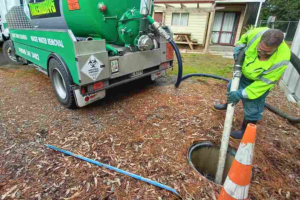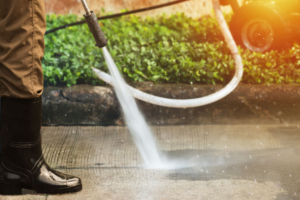Septic Tank Cleaning Perth is an essential part of septic system maintenance. This preventive service keeps your septic system working at peak performance by preventing solid obstructions from reaching the drain field.
Clogged septic systems can lead to unpleasant waste odors, sewage backups into the house, and pool water around the leach field. Cleanings prevent these issues and prolong the lifespan of your septic system

A septic tank holds a mix of liquid and solid waste. As liquid wastewater flows into the tank, microbial action breaks down most of the rest, and heavy solids fall to the bottom to collect in a dense, sludge-like substance. The liquid waste is then dispersed into a drain field for further breakdown and absorption into the soil. As solids accumulate in the septic tank, the space for wastewater decreases, and sludge is forced out into the drain field. This overflow reduces the capacity of the soil to absorb contaminants and can lead to clogged pipes, drain field failure, and costly repairs.
Regular septic tank pumping can prevent this from happening, as long as solid materials are not pushed back into the drain field. If your home has an odor, backed-up drains, or a slow toilet, these are signs that it is time to call for pumping.
A professional septic company will arrive with a truck that has a large tank attached. The tank is connected to a suction hose that literally sucks up the sewage. That sewage is then loaded into the truck and taken to a septic processing plant.
Once the septic tank is empty, the contractor will return and inspect the system for leaks or clogs. They will also look at the scum and sludge layers in the tank. The general guidelines are that if the bottom of the scum layer is within 6 inches of the tank’s preventative outlet tee or the top of the sunken sludge layer is within 12 inches of the septic tank’s vent, a septic cleaning is needed.
Septic tanks should be pumped about every three to five years. This helps the microbial ecosystem stay active and prevents the solids from carrying over into the drain field where they can clog and strain the soil absorption capability.
To extend the time between septic tank cleaning, use the toilet sparingly and only for waste. Avoid flushing kitty litter, feminine hygiene products, paper towels, and other solids. Be sure to choose septic-safe toilet paper and only put food scraps in the garbage or compost pile.
Inspection
The inspection process is important to ensure that your septic tank and septic system remain in good working order. It’s also an opportunity for the cleaner to look at any cracks, clogs and other signs of physical damage in the tank itself. This is one of the primary reasons to have your septic tank cleaned regularly. Regular cleanings prevent solid waste from accumulating in the tank and can prevent the need for costly repairs.
To perform a visual inspection, the technician first needs to locate the septic tank. This can be done by looking for an “as-built” drawing or sketch of the septic system (typically held by local health and zoning agencies) or talking with the previous owner. If no such document is available, a probe can be used to dig in the area where the tank should be located. The inspector then opens the septic tank and checks its condition. This includes checking for cracks in the tank itself, examining the risers to make sure they’re watertight and free of visible leaks, and inspecting the distribution box to be sure it is functioning properly.
The inspector will also examine the drain field and septic system for signs of physical damage. This often includes determining if the drain field is compacted, which can cause septic systems to fail and require replacement. Inspecting the septic tank will also reveal if there is any sewage seepage into the ground surrounding the septic system.
A septic tank crack that allows effluent to leak into the ground is essentially a cesspool and requires immediate replacement. The crack may be causing soil infiltration and groundwater intrusion, which can lead to severe failures of the septic system as a whole.
In addition to removing all of the waste material from the tank, septic tank cleaning involves thoroughly washing the interior walls and baffles with fresh water. This helps to reset the septic system and reduce the frequency of future pumping services. It’s also a great time to fix any broken or leaking parts, especially the septic tank lid.
Drain cleaning
If you own a home with a septic tank, there is a good chance that at some point, the drains will become blocked or slow to flow. Fortunately, there are a few things that you can do to prevent this from happening and to keep your septic tank healthy for years to come.
One of the most common causes of clogged drains is flushing items that aren’t biodegradable. This includes items such as flushable wipes, cotton swabs, and paper towels. These items don’t break down in the septic system and can end up clogging the pipes or damaging the septic tank itself, leading to costly repairs for the homeowner.
Another way to help prevent clogged drains is to use septic-safe drain cleaners. These products are designed to be effective at unclogging drains without disrupting the delicate bacterial balance in the septic tank or causing harm to the environment. Many homeowners attempt to unclog their own drains by using harmful chemical-based cleaners such as Drano(r) or Liquid Plumber(r). However, these chemicals are detrimental to the bacteria that live in your septic tank and can lead to serious damage to your plumbing and the surrounding environment.
If you encounter a clogged drain, try mixing baking soda and vinegar to create a fizzing reaction that can dislodge the blockage. This tried and true method is septic-safe, inexpensive, and easy to use. For more stubborn clogs, you can also try slowly pouring boiling water down the affected drain. Be sure to allow the water to cool completely before attempting to use the drain again.
Repairs
As wastewater flows through septic pipes, lighter solids such as coffee grounds and lint will rise to the top of the tank while heavier materials will sink and compile into a thick layer known as sludge. This separation keeps these substances from clogging pipes and straining soil absorption areas. However, solid waste accumulates over time and reduces the amount of space available for wastewater storage in the septic tank. Inspecting the septic tank to identify problems is the first step in maintaining proper system functioning. Regular pumping and cleaning services ensure safe containment levels and optimal wastewater treatment.
Septic system cleaners use a specialized process that removes sludge from a septic tank, clears obstructions and restarts normal wastewater treatment. They begin with an interior tank inspection, taking depth readings of the scum and sludge layers to determine how much of each must be evacuated. They then insert an intake hose into the manhole and connect to a vacuum pump truck to evacuate waste. The waste is then transported to a certified disposal facility, adhering to strict environmental and regulatory guidelines.
During the septic tank cleaning process, technicians also check for and repair small cracks, holes, or structural damage in the septic tank and its baffles. They also clean all septic tank access points, check for and repair broken lids and couplings, and remove the drain field line baffles to ensure that wastewater disperses evenly in the drain field after cleaning.
If your septic system hasn’t been pumped in the past three to five years, or if you notice blocked drains and foul odors, it’s time for a septic tank cleaning. Regular septic tank cleaning prevents system blockages, maintains optimum wastewater treatment and increases the lifespan of your septic system.
To minimize septic tank cleaning frequency, avoid flushing non-biodegradable materials such as wipes, feminine hygiene products, or oily liquids. Using water-efficient fixtures, conserving water and reducing the number of large household waste products that enter the system also helps reduce maintenance costs. Avoid chemical drain openers and solvents as well, since they disrupt the decomposition of organic waste and can harm septic tank bacteria.
